Geometric design creates modern garden for entertaining
I’ve been lucky to visit a number of new-to-me gardens this spring, and I have one more to show you: Jennifer Lingvai’s contemporary, designed-for-entertaining garden in Austin’s Hyde Park neighborhood. The talented B. Jane of B. Jane Gardens designed and installed it for Jennifer, who requested a low-maintenance, mostly green garden with plenty of room to entertain friends and family.
In front, a mosaic-style paver path set in Texas black gravel leads to the front porch through a no-lawn garden of low-water plants.
Block-style planting gives the garden a contemporary look.
Gulf muhly (Muhlenbergia capillaris), softleaf yucca (Y. recurvifolia), and ‘Belinda’s Dream’ roses are each planted in two evenly spaced rows and underplanted with spreading silver ponyfoot (Dichondra argentea). A Hollywood driveway (visible at right), consisting of two concrete strips set in gravel, is a green solution that reduces impervious cover and helps the property absorb rainwater.
‘Belinda’s Dream’ roses look fussy but are tough and easy-care.
An apron of gravel doubles the perceived size of the front porch and creates openness at the entry. No claustrophobia-inducing, overgrown shrubs here. An airy Anacacho orchid tree (Bauhinia lunarioides) adds height to a bed of irises at right.
As you enter the back yard via the driveway, you see a beautifully designed contemporary carport that draws your eye across a neat, rectangular lawn to the back of the garden. Additional concrete strips appear in the gravel driveway here, creating a sort of patio that aligns with a small patio with built-in seating directly across the lawn. Immediately to your left is a low, open deck — a holding space, Jennifer told me, for a future house expansion.
A closer look at the built-in seating area reveals two L-shaped seat walls with two blocky planters in the middle. A grid of concrete pavers floors the space and melds with a paver path that runs along the lawn between the deck and the carport.
The strikingly modern carport, which was designed by architect Eva Schone, doubles as a covered party space that protects guests from sun or rain. Misters built into the exposed rafters emit a light, cooling spray in summer, and a fan keeps the air moving. The enclosed section, which is clad in horizontal steel planks, with a ribbon of semi-translucent glass or plastic running along the top, contains a bathroom and storage.
An upward-swooping roof protects front-porch seating. The blue poufs were being kept dry on the chairs during my late-April visit but would normally function as ottomans or extra seating.
I love the plank-like steel siding.
Along the carport, a metal-mesh screen with built-in planters and a bench (extra seating) offers a sense of enclosure and also distracts the eye from the neighbor’s garage.
Fig ivy (Ficus pumila) climbs the metal screen and will soon create the effect of a green wall. Foxtail fern (Asparagus meyeri) adds soft texture below.
At back of the carport, a generously proportioned potting bench with a built-in sink is a delightful surprise. It doubles, Jennifer told me, as a catering station during parties.
Ivy on the back fence creates a wall of greenery.
As you come around the other side of the carport, a paver path leads you toward the deck. At right, an old clothesline was preserved for outdoor drying, with gravel neatly paving the space. Just beyond, steel planter boxes contain citrus trees.
This summer (the garden was installed last fall) Jennifer plans to hang a screen on the front wall of the carport and host outdoor-movie nights for her friends. The lawn offers space to spread out a blanket and settle in with a bowl of popcorn.
The deck provides space for additional seating and dining, at least until Jennifer decides to bump out an extension on the house. Currently the garden is accessed via a back door along the driveway side of the house, but no doubt Jennifer plans to add direct access when she remodels.
Contemporary planters on the deck hold an agave, variegated flax lily (Dianella tasmanica ‘Variegata’), and a rose.
Additional metal-mesh screening and built-in steel planters give privacy to the deck seating. Easy-care, low-water foxtail fern is massed for effect.
There are so many great ideas here. My thanks to Jennifer for allowing me to share her lovely and highly functional garden with you, and to B. Jane for the introduction!
All material © 2006-2015 by Pam Penick for Digging. Unauthorized reproduction prohibited.


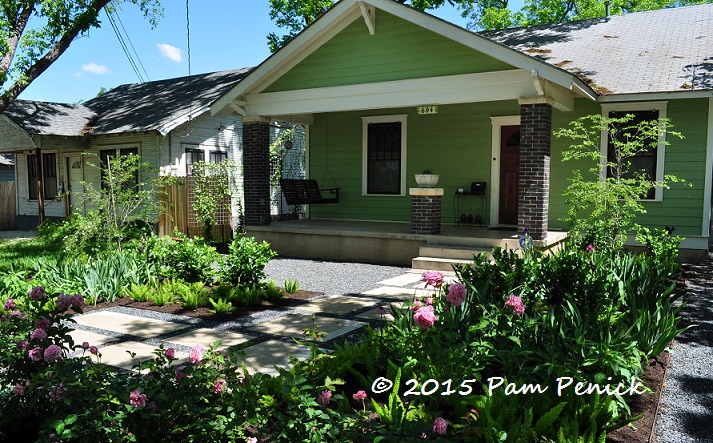
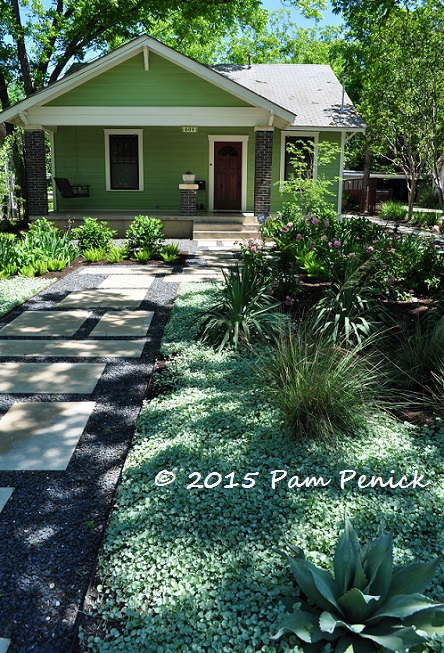
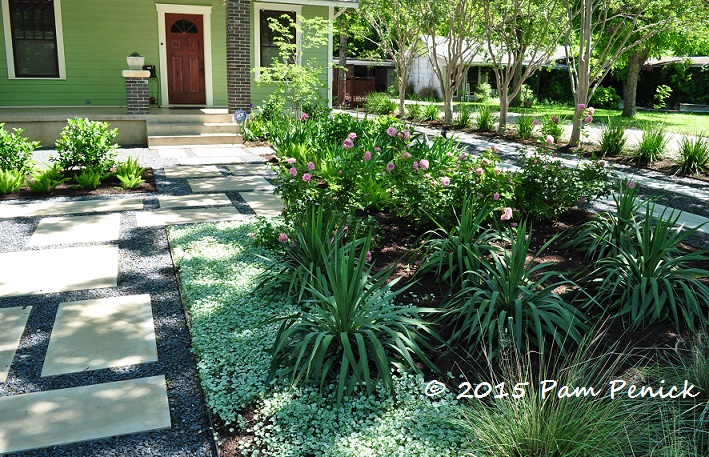
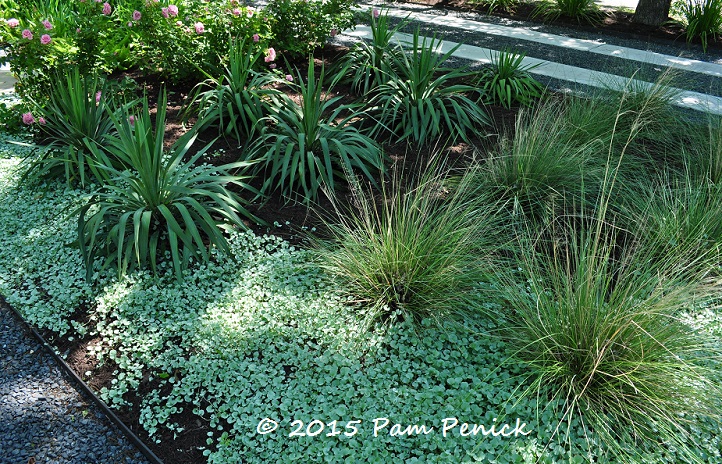
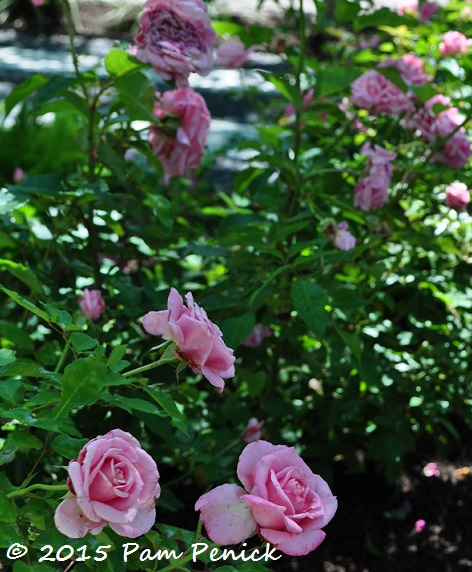
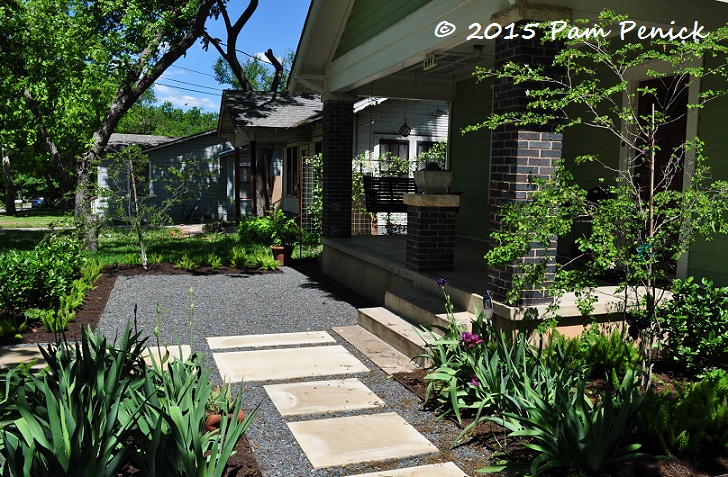
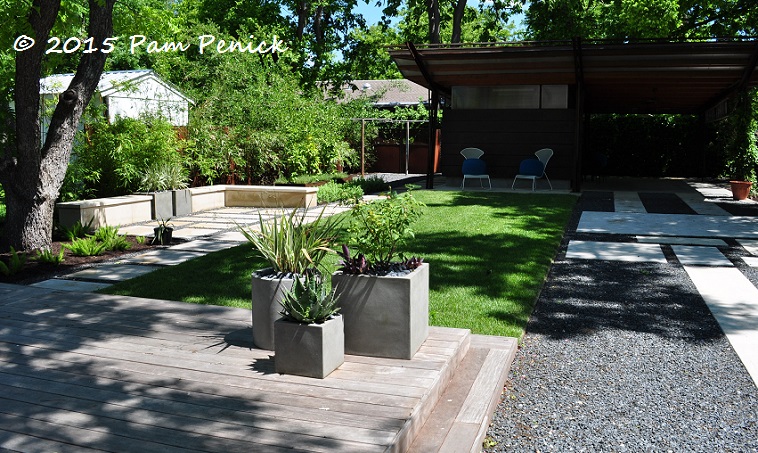
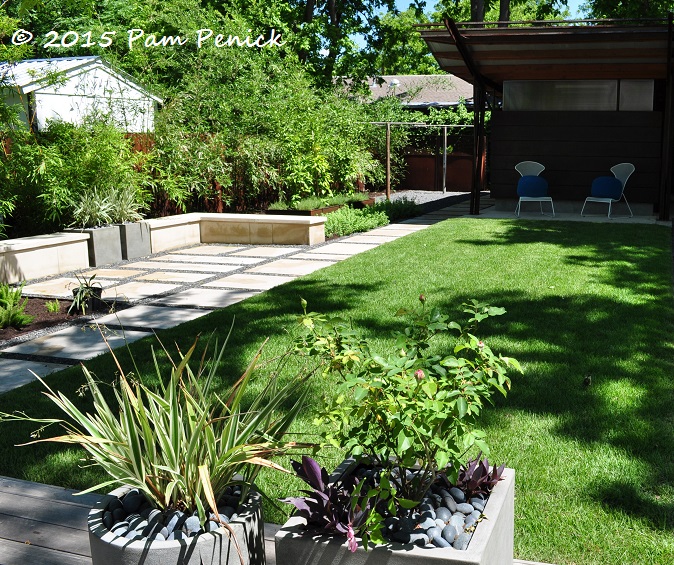
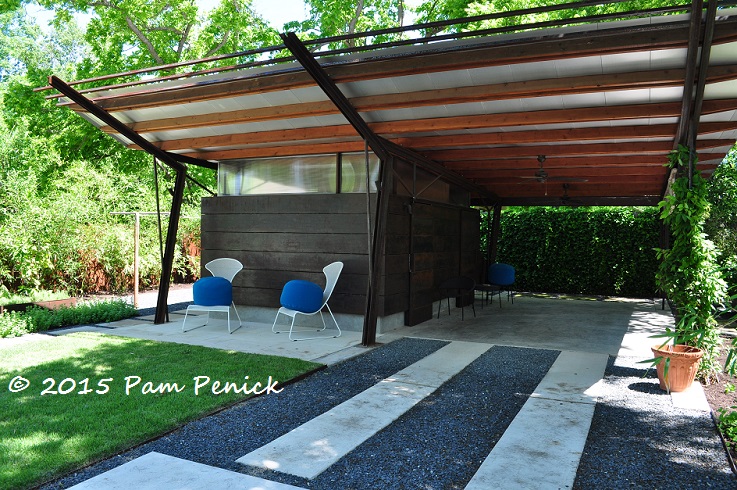
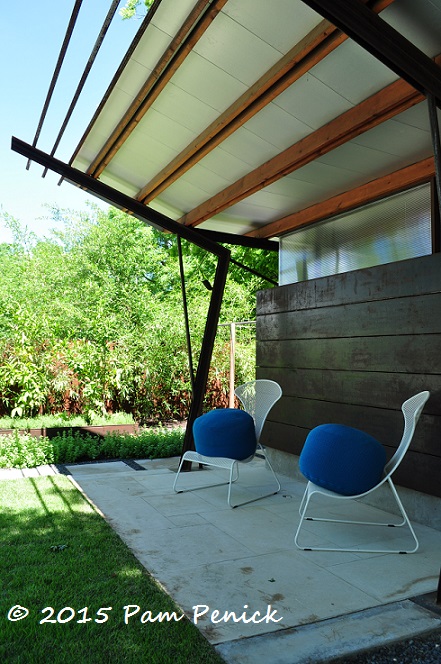
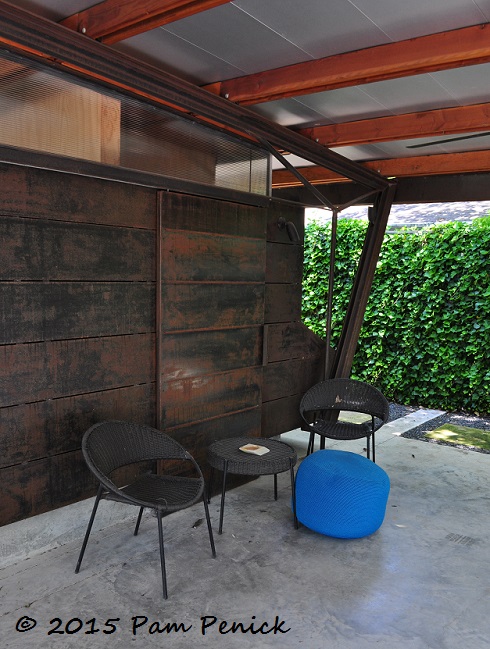
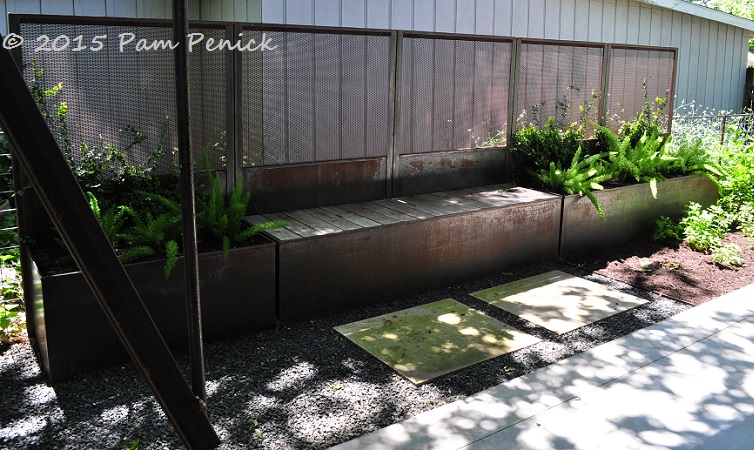
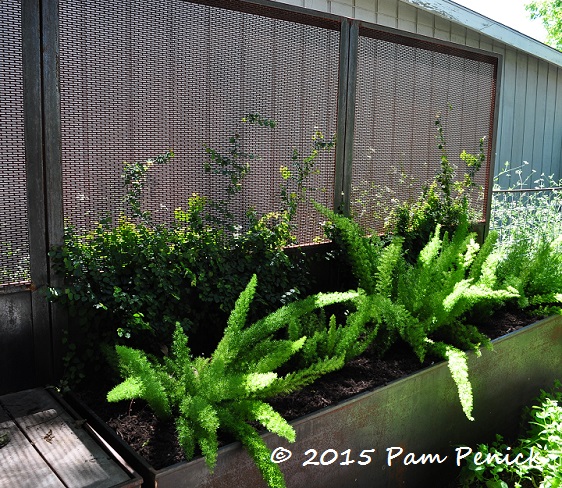
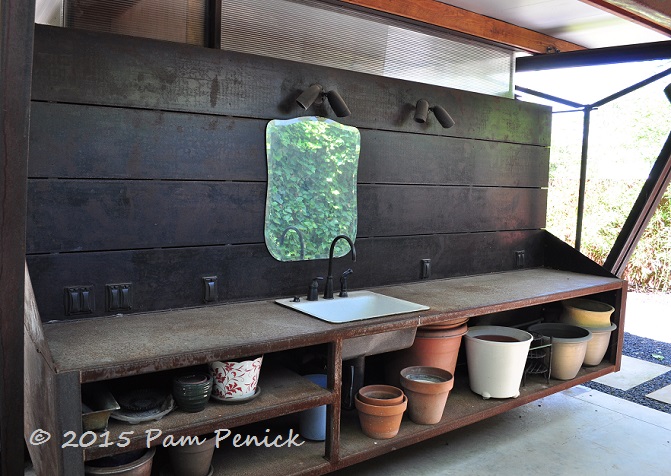
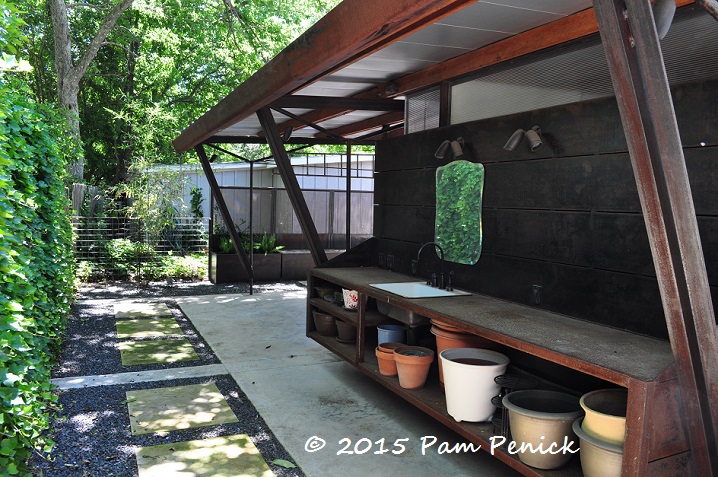
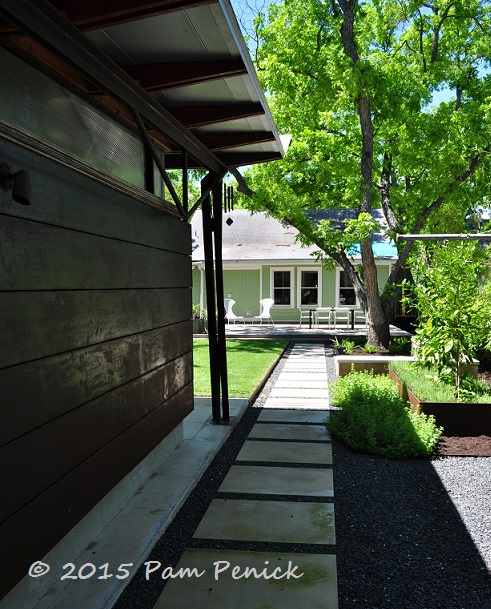
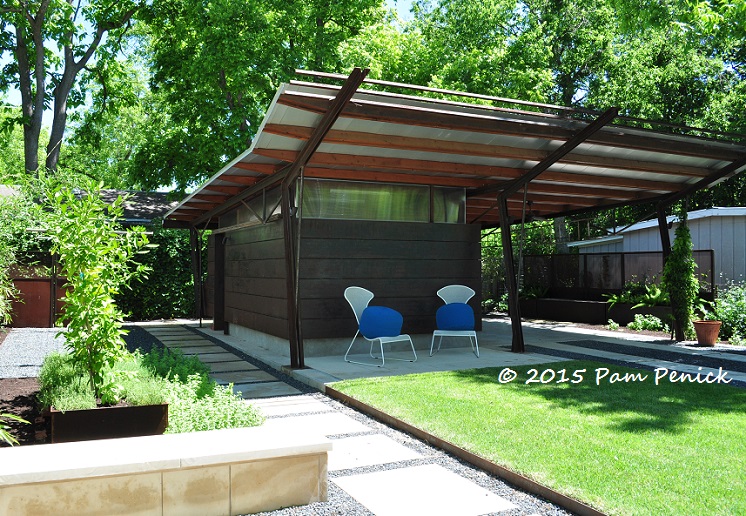
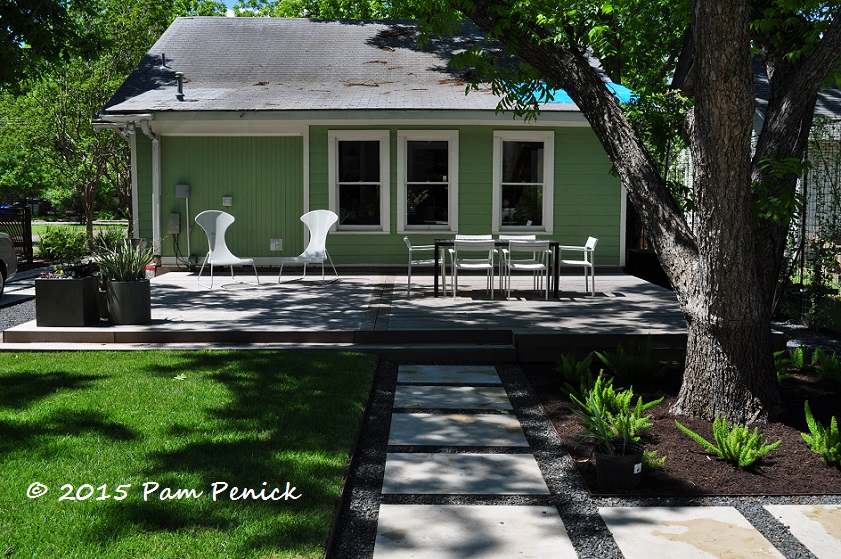
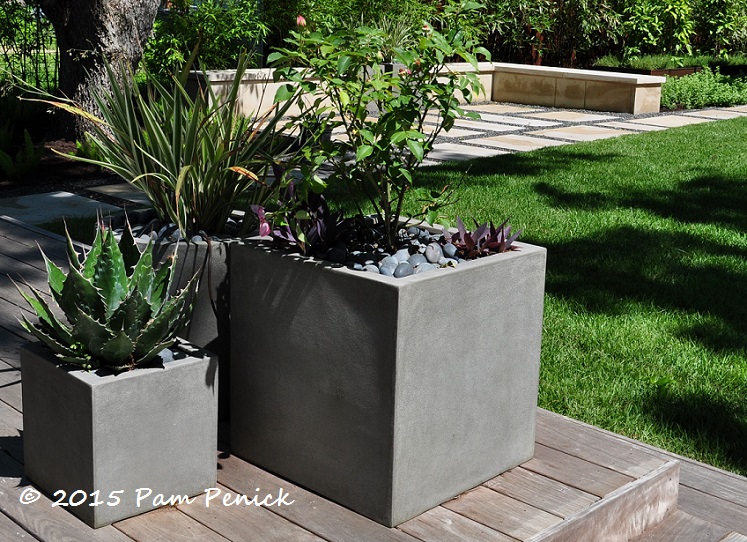
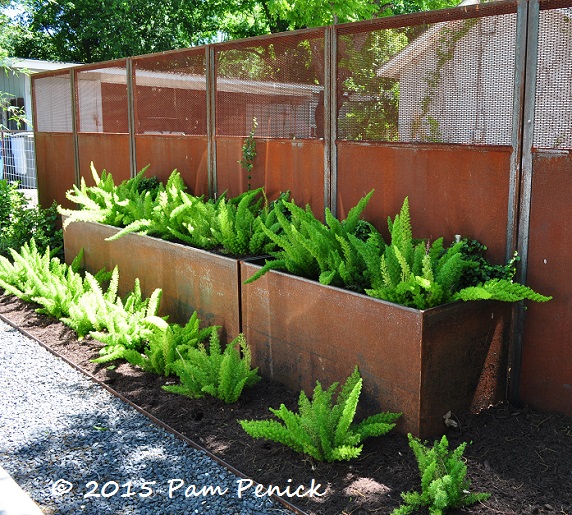
Ideas galore, Pam. There is so much to admire about this garden. I loved visiting it through your gorgeous photos and chat about it. The carport is really something. I’ve never seen metal screening like this, either, and will share with my son who’s into all things industrial. Thanks so much for sharing!
I love the metal screening too. It’s almost a shame to think of it being covered up with the fig ivy, although I’m sure that will look pretty too. —Pam
This looks great. It is low maintenance yet has personality.
Another great garden.
Fantastic!! Okay so I have one question – those roses – do they really grow in shade/part-shade? From the pictures, it looks like they get a fair bit! Being only 2 years old to Gulf Coast gardening, I am still trying to get a handle on what exactly constitutes “Full Sun” when that full sun is shining down here in Houston, TX. What do you think, Pam?
Kapila, I think I may have caught these roses at a shady time of day. I’ve grown ‘Belinda’s Dream’ in full sun with a western exposure, and it loved all that sunlight. Perhaps you can get away with a few hours of shade, but in general the more sun, the better your roses will bloom. —Pam
Thanks so much for clarifying, Pam. Texas Sun – aka The Death Star – is certainly a mystery. Longstanding adapted plants can’t seem to get enough of it; while others labelled “Full Sun” with generic plant labels simply wither away…!
You are so right — “full sun” is tricky to quantify, depending entirely on latitude and the type of plant. Many yuccas and agaves that are labeled for full sun will often thrive here in part shade or even bright shade (and of course in sun too). Small succulents like echeveria are often labeled for full sun too, but they will fry under the Texas Death Star. Still, in my experience roses like sun, the more the better. They’re crazy that way. —Pam
I love everything about this!
Perfect complement to the little green house.
How I wish I were capable of creating such a sense of order. It’s a very peaceful garden – I could feel myself letting out a deep breath as I stepped through following your photos. Great touches throughout too – I loved that perfectly placed mirror over the potting bench/catering station.
The potting bench is one of my favorite features of this garden, among many, Kris. It’s such an elegant surprise as you come around the corner. —Pam
I admire the relative simplicity of the design and carefully limited plant choices. It is so easy to get carried away with “one of everything” when plants at the nursery are in bloom and look so inviting. I think the restraint shown in this design with all its lovely greenness is exceptionally appealing. Who needs 48 different kinds of plants when a space is meant to be decorated with friends and family!
Jennifer told me that she isn’t a gardener, and although she’s looking forward to learning more about her plants, she doesn’t want to spend a lot of time maintaining the garden. Simplicity, repetition, and evergreen plants give the garden a polished look and make it easy to maintain. —Pam
“Who needs 48 different kinds of plants when a space is meant to be decorated with friends and family!”
Oh, I do which is why I just have to admire this type of garden in pictures and when I’m out and about, because I would immediately start messing up the clean lines and repetition if it were mine!
Variety is the spice of life, as the saying goes, and that goes double for gardens! And gardeners too, for that matter. —Pam
Living in the UK with a personal take on a soft flouncing cottage garden of my own, I always follow your blog with the excitement of seeing garden environments I could never have here (despite, statistically, where I live in the UK being a desert – under 6″ of rain some years. However, don’t let that fool you, we do not have the Death Star).
This posts featured garden is wonderful, and I love its restrained but soft planting, clean lines, entertaining space & of course the carport (Want!). It is very inspirational and tickles the fancy of my inner designer.
I would love to look at that space every day, but the gardener in me would be out, removing areas of grass and planting high maintenance herbaceous borders in no time.
It is however, delightful as it is.
Thanks for your comment, Nick. I had no idea that parts of the U.K. receive only 6 inches of rain a year! Death Star or no, that is challenging. As for restraint in design, I think many gardeners would agree with you that a love of flowering plants would make this style of garden unsustainable — it would quickly be overplanted. But strong design is strong design, and this garden has it in spades, which is why it’s so appealing even to us less-restrained plant nuts. —Pam
Thanks for the look into this seemingly simple landscape. Loved it. The idea of adding a gravel apron to visually expand the porch is especially appealing to me. Cuts down on lawn, too!
Good point, Judy! —Pam
So many wonderful things in that garden, the massed foxtail asparagus, the front walkway, the carport, the wonderful potting bench/party table, excellent plant selection, on and on. I’m only put off a bit by the stylistic mismatch between the bungalow/cottage pre-WWII house style and the more contemporary style of the garden and carport.
I actually like that dichotomy, Hoov, but of course it’s a matter of personal taste. The front-yard garden is modern too, with block-planting of plants. I like the contrast (update?) of old vs. new. —Pam
What an amazing and original use of space!
I love the look of those large pavers BUT I have noticed that with all the recent rains, many of these concrete pavers are green with algae. What do you think would be the least toxic way to bring them back to their original white gleaming selves?
That’s a good question, Sherry. I haven’t had any experience with that myself. I would suggest a small amount of bleach in a bucket of warm water and a scrub brush, but there may well be a better way. —Pam
Any suggestions on if I can buy the concrete pavers ‘off the shelf’ those work so well in the landscape and they look perfect for foot traffic through the garden!!!
Sure you can, Jenny. Home-improvement stores and some garden centers carry 12- and 15-inch square pavers, and I’ve occasionally seen bigger ones offered too. —Pam
Do you have any idea where these particular concrete pavers were purchased? They would be ABSOLUTELY PERFECT for a project I have. I had another question about the silver pony foot. I’m working with a client in Houston and she has a super contemporary garden that we are renovating. I think that this might be a good groundcover to use but it’s in dappled to heavy shade all day. Would it still work as well as the Gulf muhly? I know they both need sun but it looks like these are in dappled shade…
Your blog is AH-MAZING by the way! I’ve been following you for quite a while and you’ve been an invaluable resource for me! You have excellent images with ID’s and great pertinent information for landscape designers. WELL DONE!!!!!!!!!!!!!!!
I don’t have the source info, Jenny. I suspect they were poured in place because so much custom concrete work was done in this garden.
Re: the silver ponyfoot, I’ve learned never to predict what will grow well in Houston because conditions are so different from Austin’s: 50 inches of annual rain vs. our 33 (if we’re lucky), and acidic soil vs. our limestone. I think the biggest challenge would be drainage for the silver ponyfoot. I recommend you ask Laurin, a Houston designer who blogs at Ravenscourt Gardens, to see what she thinks. Good luck! And thanks for the nice words about Digging! —Pam
Lovely landscaping at this home. I saw another of your older blogs of an expensive home Westlake home, I believe, where they used Texas Black Star gravel on top of their entire landscape. I put about 1-1/2″ of Black Star gravel on top of my 3 large potted Aloe Veras soil. It looks nice but 1 large leaf already broke off–possibly because I was using another plant leaf to bend a bowed over leaf into a better angle but possibly because the gravel is too gritty and sharp for the 90%+ water Aloes. Would you recommend removing the Black Star gravel from my potted normal agaves? Could it cause damage to them? I can’t find any info about this on the net. Thanks!
Bob, I don’t see why the gravel would cause leaf breakage like you mentioned. Aloes and other succulents need really sharp drainage, so fast drainage wouldn’t be a problem. Perhaps it was broken by an animal, like a squirrel? The leaves of many succulents are quite fragile. —Pam
Thanks Pam. It may have been my dogs that broke the leaf, but my poor Aloe Veras are already in ceramic pots that I know are too small for them. The Black Star gravel was causing such compaction that new leaves could not squeeze out and the center of one Aloe was ‘bleeding’ from being so compacted. I just solved the problem by moving most of the gravel out of the pots to a bed of Weber agaves that have no space issues. I’ve adding more perlite to the potted Aloe soil for drainage and more ‘breathing room.’ My Aloes already look happier. I really enjoy your blog! Thanks!
I’m glad you figured it out, Bob! Thanks for reading Digging. —Pam